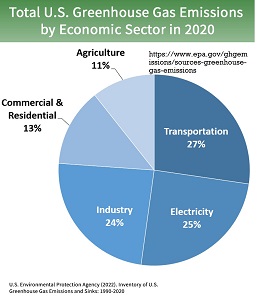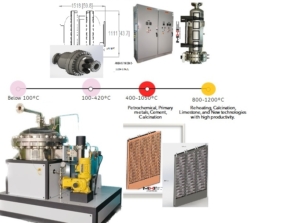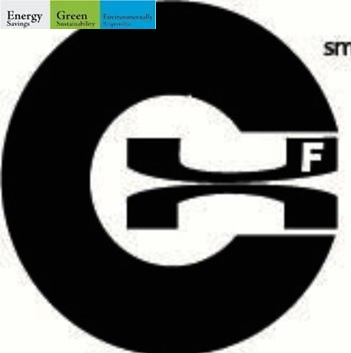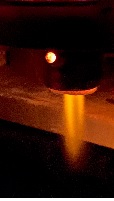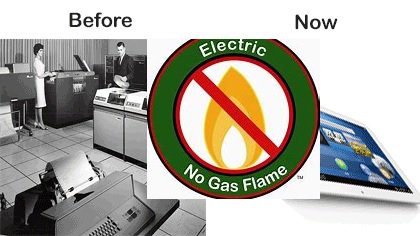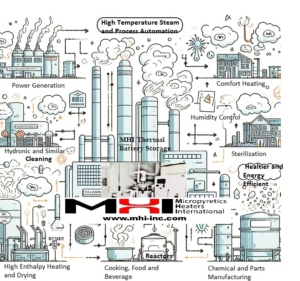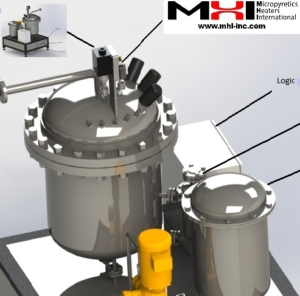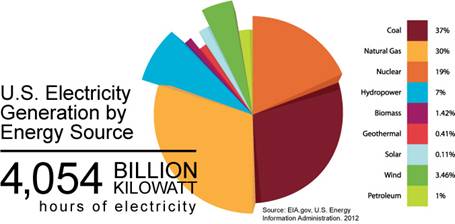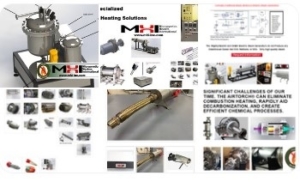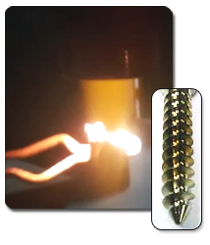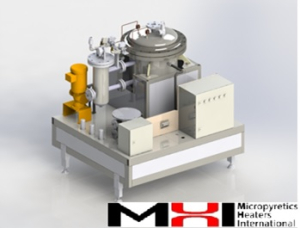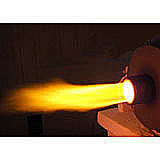Energy Savings: Why Should We Be Concerned With Conserving the Quality of the Available Energy.
Energy, Power, and Thermodynamics Tutorial
The JOULE (J) is a unit of energy. The BTU is also an energy unit.
Electric companies employ kWhr (Kilo-Watt-Hour for electricity usage) or Therm (for gas).
1000J = 1kJ (KiloJoule) = 0.9485 BTU=0.0002778 kWhr
1 kWhr = 0.03413 Therm [U.S.]= 3.6e+6 Joules.
One Therm (TH) = 100,000 BTU
Review Radiative heat Transfer.
Checkout Decarbonization Information and products.
Energy is ubiquitous. It is required for everything. Although the total energy is a conserved quantity, the quality of energy degrades when energy is used. This is why the quality must be conserved. We use and degrade about 400EJ (EJ = ExaJoules) of Energy annually. Improving energy efficiency implies doing better with less energy. The efficient use of energy saves money. The efficient use of energy preserves the quality of the energy. This is an aspect of deep decarbonization.
1 ExaJoule = 1,000,000,000,000,000,000 Joules. This amount (of energy used per year) is increasing, so the quality of available energy is decreasing. All of us must do our part to manage energy better. One way is by utilizing SmartThermal™ devices. These new machines and devices considerably reduce the end-use energy required for a defined objective. A few such devices are discussed below.
1 PJ (PetaJoule)= 1,000,000,000,000,000 i.e. 10^15 Joule.
1EJ (ExaJoule) =1,000,000,000,000,000,000 i.e. 10^18 Joule.The Watt (W) is a unit of power, i.e., the energy used (or supplied) per unit of time.
1 J/s (Joule per second) = 1 W (Watt)
Power is sometimes expressed in alternate units like BTU/hr or Horsepower (hp)
Power-Units Conversion 1 kW (KiloWatt) = 3414 BTU/hr
0.746kW= 1hp
The power rating of steam boilers is in units of BHP (boiler-horsepower)
One BHP (Boiler Power)= 33,500 BTU/hr = 9.803 kilowatts
(The Boiler-BHP power unit is a bit confusing because BHP could be confused with brake-horsepower (bhp), which is an auto-industry terminology)
Despite all the talk of “green energy,” fossil fuels still supply about ~ 80 percent of all world energy in 2022. The use of coal is now falling (down from 30 percent in 2015 to 27 percent in 2020), while renewables are increasing (up from 2 percent in 2015 and 3 percent in 2016 to 6 percent in 2020). Natural gas produces about 117 pounds of CO2 per MMBtu equivalent, which is about half the amount produced by coal for the same amount of energy; however, if counting H2O and CH4 (methane), the major component of Natural Gas, the natural gas production of GHGs is very high.
Smart, efficient, and sustainable electrical, and industrial heating is the key to success. Computers were miniaturized with smart materials, and advances in nanomaterials processing are now miniaturizing thermal devices. We must use smart heating devices for quick decarbonization.
Spurred by the understanding provided by modern thermodynamics, good progress has been made in developing smart energy devices. A range of industrial-use innovative- products that perform the same objectives as before but with lower energy use (by >90% or more improvement) have now become available. The US manufacturing sector accounts for almost 10% of the GDP and uses nearly 30% of the energy generated. Nearly half of this energy (thousand trillions of KiloJoules per year) is used for steam and process heat (reference from DOE publications). Any improvement in this usage is expected to help with common energy issues and save considerable money. When energy is used for an objective, it is often used in a manner that changes the type of energy employed and almost always degrades the quality of the energy used. Any energy-conversion device for an objective – such as lighting, anti-bacterial steam production, process-heat generation, or transportation- can be considered a machine. Such machines are rated by their power. Power is the measure of the rate of energy conversion. The most commonly used engineering units for power are Kilowatts (i.e., Kilo-Joules per second) or BTU/hr. 2 kW = 6,829 BTU/hr. The 2 KW number is an approximate average value for daily use devices used for cooking, lighting, drying, ironing, transportation, and other devices commonly used in a US household. As suggested in one of the articles in the Journal “Nature,” Oct. 2017 issue, the use of high-temperature and high-temperature energy transfer can lead to some of the best efficiencies and productivity enhancement for many processes employed for materials and energy conversions. This is the MHI specialty. MHI manufactures devices that significantly reduce the energy required downstream, whether it is processing with superheated steam (compared to standard steam) or manufacturing friction-free surfaces with the cascade e-ion plasma (compared to normal plasma).
Energy Conservation allows us to benefit from the Mechanical And Thermal Advantages that Levers to Heat Pumps provide.
For most individual users, a good energy efficiency profile and related cost savings are enabled by using less power for the same process objective in a shorter time. Most often, this is best enabled using high-quality, higher-grade energy deployed by a modern smart-power device. Great scientists, mathematicians, and technologists – several mentioned below, have influenced the development of smart devices. Such devices are now used in both the commercial and industrial sectors. Electric high-temperature devices are an essential group of smart power devices. MHI specializes in high-temperature materials, devices, and controls.
The brilliant Emmy Noether (1882-1935) provided the fundamental reason for energy conservation. The understanding of the principles of energy conservation (The First Law of Thermodynamics) with “heat” and “work” equally included in the balance arguably began with Nicolas Sadi Carnot (1796–1832), Julius Robert Mayer (1814–1878) Rudolf Julius Emanuel Clausius (1822– 1888) James Clerk Maxwell (1831 –1879) and James Joule (1818–1889). The primary laws of thermodynamics are (i) the quantity of energy in the universe is conserved – confirmed by a remarkable analysis made by Emmy Noether (1882-1935) and (ii) energy possesses both quantity and quality type properties – firmly established in the 20th century. Simultaneously, the energy principles of chemical reactions, light, and ionic species were brought into the fold of thermodynamics and quantum mechanics by great scientists like Théophile Ernest de Donder (1872 –1957), Hermann Ludwig Ferdinand von Helmholtz (1821–1894), Max Karl Ernst Ludwig Planck (1858–1947) Albert Einstein (1879–1955) Josiah Willard Gibbs (1839 –1903) Alan Mathison Turing (1912 –1954) Ludwig Eduard Boltzmann (1844–1906) Boris Pavlovich Belousov (1893–1970) Lars Onsager (1903 –1976) Richard Phillips Feynman (1918–1988) and several others. The mathematical results on the organizations of numbers and their related patterns, as advanced by Srinivasa Iyengar Ramanujan (1887–1920), are now playing a growing role in modern thermodynamics analysis by relating to ideas regarding physical patterns that are observed all across nature. A deep understanding of physical patterns is the basis for many optimizations and smart-device evolution/manufacture. The latest progress in thermodynamics concerns the maximum entropy production density rate for describing processes/patterns and quantum entanglement. Some concepts, such as dark energy and the quantized states in nucleons, remain somewhat unknown. Energy is commonly measured in Joules (J). In physics, natural units are used for energy reporting, namely, the Planck energy unit (Ep), which equals 1.956 x 10^9 J (about 2 Billion Joules). We estimate that we use more than a billion Planck units of energy every year.
About Energy:
- The word “energy” originates from the Greek word Enárgeia. Developed by Aristotle, Enárgeia has no direct English translation except when referring to activity.
- Thomas Young coined the word “energy” in its modern physics sense, referring to kinetic energy around 1807. Soon afterward, other forms of energy were described, including potential energy, chemical energy, and electric energy. The SI unit of energy is the joule (J). Today, we strive to conserve the quality of energy.
- Did you know that the units of pressure are J per unit volume? More Units.
- The earliest recorded use of electric energy was probably in ancient times when Egyptians and Greeks used electric fish to produce shocks for medical purposes. They used an “electric fish” for its numbing effects to treat ailments like headaches, gout, and epilepsy.
- Centuries later, scientists like Benjamin Franklin conducted experiments on electricity—his famous kite experiment in the 1750s proved that lightning was a form of electricity. In 1800, Alessandro Volta invented the first electric battery, the “voltaic pile,” which provided a steady flow of electrical current.
- Michael Faraday, with his work on electromagnetism and the invention of the dynamo generator, paved the way for the industrial use of electricity.
The typical order-of-magnitude power rating for commonly used devices is shown in the table below. The new Smart Devices that consume less power than traditional machines offer a lower number in the range within a category. The order of the unit price paid in the US for power-consuming devices is also shown in the table below. Lower power-use (kW) devices, when they perform the same objective in less time than higher-power traditional devices, are often referred to as Smart-power devices.
Smart power devices are energy efficient, offer low footprint/weight, increase productivity, and lower pollution. One may expect to pay about $1 or more per watt (in capital costs) for a smart device that produces heat or work as the objective, especially if the device is flameless and mainly flameless and non-toxic, i.e., no Methane/CO/CO2/NOx is produced or leaked at/by the device.
“The best ideas on how to do our part to assist energy efficiency with smart power devices include the use of lower amounts of high-grade energy compared to the use of large amounts of low-grade energy for the same objective.” The impact of climate change can be mitigated by deep-decarbonizing the industrial sector.
- Clean industrial manufacturing methods can reduce CO2 emissions dramatically. Free calculator.
- A United Nations report concluded that average global temperatures are on track to warm by 2.1°C to 2.9°C by 2100. As a result, the world can expect a dramatic rise in chaotic, extreme weather events.
- The possibility of extreme weather events related to the rise in global temperature should prompt us to reevaluate the basis for industrial project costs.
- Many forms of clean energy are cheaper than many fossil fuels that cause CO2 and other toxic emissions. The social cost of CO2 production varies from US$51 (Federal Estimate) to about $411 per ton of CO2 (Independent Estimate Click here).
- Reducing fossil fuel use (e.g., oil or natural gas heating) in the industrial sector can significantly improve the payback time for all new projects.
| Device Type | Light Bulbs | Home Cookers Refrigerators/ Washer/Dryers | Cars | Industrial heaters |
| Typical Power Rating of a Device, kW | 0.03-0.2 kW | 2-5 kW | 20-300 kW | 60-20,000 kW |
| Price (typical only) in US dollars | ~ $1 | ~ $1000 | ~ $10,000 – $200,000 | ~ $50,000 – $1,000,000 |
| CO2 saved by going electric (per one device) | small | small | 2-20 kg/hr | In the order of Tons/hr |
Similar progress toward smart power devices has occurred in the industrial world. This has happened mainly because modern devices can now use/deliver high-grade energy for their intended function, i.e., they have evolved as smart power devices.
An example of high-grade energy is high-temperature energy. Some comparisons of how devices have evolved are discussed below:
Old steam boilers ~150 kW. New HGA and OAB steam generators ~ 1 to 250kW
Old surface modification (engineering) methods ~200 kW. New Cascade Ion Methods ~10kW.
Energy is consumed and paid -for in units of kWhr (Kilowatts multiplied by the hours used).
One kilowatt-hour (kW-hr) = 3,600,000 Joule =.03413 therms [US] ~ is priced at about (9 to 15) US Cents/kW-hr.
House gas stoves for cooling are typically rated for ~7000 BTU/hr (about 2 kW) power.
The table below estimates possible savings when using a more electrically efficient product. The assumptions for the calculations below include continuous use for a year and an energy price of 1kWhr=10¢ (US cents). This is the approximate energy price when obtained from a reservoir like the electric grid, ample gasoline supply, or a continuous gas supply – if energy is obtained from a drainable battery, the price per watt could be even four times higher.
Reduced power consumption by: | 1kW | 10kW | 100kW |
Possible savings per year of: | $876 | $8760 | $87600 |
| Examples of such lightweight devices: | Light Bulbs/Microheaters | OAB | Cascade e-ion |
What is Energy? What is the Quality of Energy? The latent ability to carry out an objective. Energy has at least two characteristics associated with it, (a) the amount (of Energy in SI units of Joules, J) and (b) the quality of energy, a more relative measure inferred by calculating the loss of potential following an energy-use process (units of Joules per Kelvin. per mol/m3, i.e., J/K.molar density). Units: Electricity (more correctly, Electric Energy) is priced by the KWhr of energy use, whereas Gas Energy (Fuel Energy) is priced by the number of Therms generated during use. Note that 1kJ (KiloJoule) = 0.9485 BTU=0.0002778 kWhr (kilowatt hour). One Million BTU (MBTU) = 10.002 Therm [US]. And 10 Therm [U.S.] = 293.0 kilowatt hour. More.…..
What happens when we combust fuels for energy production? The following table shows the pounds of CO2 emitted per million BTU (~1.05 Million KJ) of energy from various fuels when combusted. Assuming that a US household consumes energy at the average rate of about 2 KW (~7000 BTU/hr) across a day, a Million BTU or KJ number is the approximate equivalent of about 100 lbs. of CO2 emission per week per US household if the energy was produced by combustion (e.g., from natural gas, gasoline or oil). We have not considered the use of automobiles use in daily energy use.
How much CO2 do humans produce when breathing? The average human exhales about 2-3 pounds of carbon dioxide (human activity averages at about 100 Watts or 0.36 BTU/hr)) on an average day (about 15- 20 lbs a week). The exact quantity depends on the activity level (higher activity, more CO2 exhaled). The amount of carbon a human breathes out is almost equal to the amount of carbon a human takes in (from food) minus the amount of carbon that contributes to the person’s body mass. Thus, the amount of CO2 humans exhale is roughly balanced by the amount absorbed by plants and other photosynthesis-type reactions. However, note that the human population is approximately 7.5 Billion people. Thus preserving forests and using renewable sources for energy, and not using combustion as an energy source during use is essential. What is the greenhouse effect?
Is Momentum Conserved? Why? This has to do with Noether’s Theorem. (Noether’s Theorem – Wikipedia ), Noether’s Theorem is a statement from mathematics with several critical physics applications. It says that if the equations of some system obey symmetry, then some conserved quantity is associated with that symmetry. The fact that the laws of physics are the same at any point in space implies that some conserved quantity is associated with this spatial symmetry. It turns out mathematically that this conserved quantity corresponds to what we already defined as “momentum.” The fact that the laws of physics do not change over time implies that some conserved quantity is associated with this temporal symmetry. It turns out mathematically that this conserved quantity corresponds to what we already defined as “energy.” The fact that the laws of physics are the same in every direction in space implies that some conserved quantity is associated with this directional symmetry. It turns out mathematically that this conserved quantity corresponds to what we already defined as “angular momentum.” So by Noether’s Theorem, the quantity we call angular momentum must be conserved in any universe where the laws of physics are “isotropic” or direction-independent.
Why Use Electric Energy? It is the Genesis of SmartPower Devices and provides a platform for non-toxic energy conversion to valuable objectives. Electric heating devices do not produce Methane or CO2 during use unless specifically intended for a process.
| Weight of Carbon Dioxide per One Million BTU of Burn | Pounds (lb) (approx) |
Diesel fuel /heating oil | 161.3 |
Gasoline | 157.2 |
Propane | 139.0 |
Natural gas – CH4 is a very strong GHG gas) | 117.0 |
| E-Ion Plasma, HGA, or OAB steam at the device | 0.0 |
What is Sustainable or Renewable Energy? Energy can be stored/available in various forms, e.g., electric, gasoline-burning, or from water or wind velocity. We use this energy directly to power a device or convert it (e,g. electricity to heat or vice versa) for a specific objective to be carried out. The energy we receive and convert for an objective can be reused or available from an infinite reservoir. Almost all the energy we use is reused because of the energy received previously or currently from our solar system. Some exceptions are the energy received from deep space, primarily as neutrinos, gravitational, and electromagnetic waves. Note that the conversion of solar, nuclear, or wind energy does not generally produce CO2. It is equally important not to make CO2 at the use point. Note that the OAB® or other MHI devices do not produce CO2 when used. Where possible, electric-only or hybrid solutions should be employed for energy use, i.e., to avoid a net reduction in CO2 production.
Potential Energy, Kinetic Energy, and Thermal Energy: When we use energy, it is the energy that is stored either in bonds, both nuclear or chemical bonds (nuclear or chemical energy potential) or in the gravitational force fields that make water flow from reservoirs (potential energy/kinetic) or as concentrated charge carriers stored in a battery (as electric potential/field). The use of kinetic energy is related to the momentum of wind or sea waves. Thermal energy (measured as temperature) is stored in the vibration of molecules or smaller particles. Thermal energy is transferred as heat. Energy can be changed between energy types, although converting from one form to another may incur a penalty sometimes. We often transfer or convert Energy/from heat or work to a different type of energy. Energy is always conserved.
Sustainable energy is commonly defined as energy that does not exhaust a source of its energy or mass content shortly. Or at least it will not run out for future generations, e.g., direct radiation from the sun. More on chemical bonds, radiation, thermodynamics….solar efficiency…., A clean energy device does not produce harmful emissions (like methane or CO2) when energy is used/converted by the device. Sustainable energy leads to responsible engineering.
How much does energy cost? Very approximately ~10¢ per kWh or ~9¢ per 0.0341 Therms [US] to most users. The price paid per unit amount of energy is very similar (to small-scale users) whether the energy is used in electricity, natural gas, or even gasoline (a bit more variation in price is noted in gasoline). Of course, some energy sources are expensive for now but are expected to reduce over time, e.g., volcano energy.
What is Energy Efficiency? Is Energy Conserved? The total energy is always conserved. However, the energy of one type can be changed into a different kind of energy (with a different quality). Thus energy can be degraded (when used). Energy efficiency is enabled by using less power for the same objective in less time. Energy efficiency is also related to the minor degradation type of use, i.e., the slightest change in the quality of energy after the energy is used for an objective. If a process that uses energy for an objective also produces new entropy (units: J/K.mol) during the process, then the energy used has been degraded. When new entropy is produced, it is called irreversible entropy production during a process. The creation of irreversible entropy is not necessarily bad, as it also often defines the shape and beauty of different shapes. Learn more about this from the second law and critical aspects of how energy is degraded during use.
If the price is not that different, what does Energy efficiency mean to a user? To most individual users of energy, improved energy efficiency implies the use of a lesser amount of energy use for the same objective. Using less energy equals less payment for that energy. The price of energy fluctuates a bit for every energy provider or distributor, e.g., click here. When checking for the best prices, you will note that the energy delivered to you, whether electric or gas, will cost you almost the same per unit of energy! So the gains from better production methods could be marginal, albeit significant, when offering a lower price of the delivered energy.
Regardless although the two laws of thermodynamics always set theoretical limits – sometimes the use of energy may cleverly be reduced by transformative new technologies within these limits. More on a new postulate for pathways and self-organization…... More on Efficiencies.. …
Quality is often a comparative concept that relates to the fitness of use! High-temperature energy is one form of high-quality energy. The quality of energy is also often measured by the available work potential.
Are there examples of devices that improve Energy efficiency substantially? Yes, particularly those that use smart power. These include Efficient Photonic Devices, Efficient Cars, OAB® Steam and the Cascade e-Ion Technologies for Surface Enhancement Engineering, and many more. A photograph of a modern OAB® efficient steam generator and a Cascade e-Ion producing plasma from the air are shown below. These are new transformative technologies for improving energy consumption using smart power.
What is smart power? The choice of technologies that allow improved energy efficiency and improved working environment. For example, the use of high temperatures often cuts down on the use of wasted energy by speeding up most processes. This has led to lower energy use in lighting, surface treatment, process air heating, and steam from textiles to packaging. Using high-grade energy (smart power devices) is essential to all of us. A high-grade energy example.….
New Concepts in Energy Use: A developing new law of thermodynamics to predict how shapes of things evolve...link here for an update. It is a current topic, not yet fully understood!
High temperature equals higher productivity. Use high-temperature SmartSteam instead of high amounts of low-grade energy. This is smart power usage.
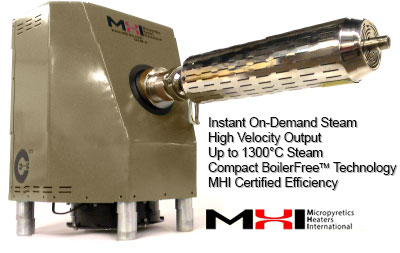 Does Energy Efficiency also imply less pollution? Yes. When energy is used (i.e., spontaneously transformed from one state to another), it is degraded. Degraded energy is lower-quality energy, often also directly or indirectly enhancing pollutants.
Does Energy Efficiency also imply less pollution? Yes. When energy is used (i.e., spontaneously transformed from one state to another), it is degraded. Degraded energy is lower-quality energy, often also directly or indirectly enhancing pollutants.
When using electric energy (an ordered form of energy) versus gas combustion (a disordered form of energy) for a process, additional energy efficiency arises from better control, less harmful emissions, and other process-related factors. Combustion of carbon-containing gases (directly or indirectly) creates CO2, which along with any leaks of Methane (Natural Gas), helps contribute to erratic atmospheric patterns. See spectra…
Improving industrial processes’ heat transfer rate (speed) becomes more critical as production demands increase. They are improving the speed with less power. MHI provides the best rates for power machines coupled with energy efficiency and often for the financing options for your success. Financing solutions include the enabling of monthly payments. Approximate payment calculator (please click). Please compare the Return on Investment (ROI) for an estimate of daily net earnings. Broad examples are given below; however, please get in touch with MHI for accuracy and applicability to your specific use.
ROI Scenarios. Please contact or call MHI sales for details for your use. Some of the returns on investments can be very large. In the case of OAB® products for certain CPG or hydronic heating, the power savings could range from 30% to a whopping 90% in specific scenarios. For some of the Nanostructured GAXP® heating-element configurations, a good scenario, based on a four-year amortization schedule, shows that a $13K monthly investment can lead to a $1M return when adequately installed – i.e., considerable monthly net savings for specific Cascade e-Ion™ applications. A 2K monthly investment may return $100K monthly net savings (four-year amortization). A relatively light $312 investment in a modern Airtorch® system for enhanced and environmentally friendly die-heating can lead to a $14K monthly net savings (four-year amortization scenario). Scenarios will differ for the ROI for every client and every installation, and the best-estimated ones are cited above. Please get in touch with MHI to discuss your specific use and assumptions for the above scenarios. MHI has invested in creating and patenting energy-efficient technologies and has gone further by commercially producing devices and creating a large group of satisfied customers.
We look forward to adding your name to the hundreds of satisfied MHI customers.
In today’s manufacturing world, significant savings can be had from reduced energy use, better environmental performance, and improved outcomes of a new enlightened plant. MHI devices are fundamentally structured to provide these three benefits. The technology for heat-energy production has dramatically improved in the past ten years, with nanostructured GAXP®, Airtorch, Cascade e-Ion, and One Atmosphere Boilers (OAB) leading the way. In the table below, an approximate calculation shows savings from using a more energy-efficient machine. The assumptions are one year of continuous use and 10¢/kWhr. IModernthermal energy devices can provide good value. MHI is a choice that many users have made to help save energy and the environment. Please review the testimonials.
Small Print! and Disclaimer:
| This return on investment (ROI) analysis is very approximate. Savings and benefits to the user could be more or less than presented above. The calculations shown are meant to be indicative and will vary for specific applications, equipment, and use conditions. This is an approximate guide, and the template should be modified for the customer’s specific use. Interest rates, energy, equipment, and other costs used in the analysis are always subject to change. MHI does not guarantee or warrant any specific ROI analysis that a purchaser may use in their decision-making process. The responsibility for an accurate ROI calculation rests solely with the buyer/user. Financing is not guaranteed and depends on several factors that MHI does not control. |
Information and Tutorial Resources
To understand the basics of energy and power, please click on MHI 101 Power and Energy tutorial + calculator. Public-Private partnerships exist all over the world to improve energy efficiency. Some are briefly discussed below. The following external links are provided as a public service and are not intended to create relationships.
Energy Efficiency Help: Please use the DOE link below to search the State Incentives and Resource Database. The State Incentives and Resource Database is designed to help those seeking to make energy-efficiency upgrades to their facilities. It is a repository of energy incentive programs, tools, and other resources for commercial and industrial energy managers. Incentives and resources are available at the national, state, county, and local levels. Power utilities, private companies, and non-profits also offer incentives for energy efficiency measures, including rebates, waived fees, tax credits, and loans. Resources include analysis tools, education and training programs, and energy audits. EPA Funding Opportunities for improving energy efficiencies.
Environment Help: The generation, conversion, and use of energy can affect the environment. The United States EPA’s regulatory and voluntary programs foster more responsible production and use of energy resources. The link below lets you learn about important energy topics and locate information about EPA energy programs. EPA Clean Energy contact: State Utility Commission Assistance (202) 343-9631. http://epa.gov/energy. Today, you may be able to quickly capture the value of energy savings to you with many of the programs offered by various governments and utility companies. MHI can suggest methods to help you establish energy efficiency with MHI products and technologies. Below are US-based links to online resources and programs that offer incentives and rebates for energy efficiency and emissions compliance. There are similar energy programs in almost all countries. You could use some of these programs to secure low-cost loans, grants, and energy rebates to purchase MHI energy-efficient products. For many typical configurations and uses, the GAXP and Airtorch® efficiencies could allow about 10kW savings, Cascade e-Ion and OAB solutions may allow over 100kW, and more. MHI furnaces also offer Fiberfree™ insulation and special nanostructured roof hangers. Please get in touch with MHI and join the SAVINGS newsletter.
Regulations and Green Offerings: Pressure certificates, ASME, and local government regulations vary considerably and could change, so please confirm with local authorities. Steam generators that operate at One Atmosphere (like OABs and HGAs, and others) may not need certifications. Please click here to review some of the codes posted on the web.
* Based on 2015-2016 Estimates
Target | Energy and Environmental Benefits | MHI Device |
| Transformative Ion Heating Systems | Use powerful CleanElectricFlame™ for continuous VOC removal, rapid heat treatment, and surface treatments like finishing to hardfacing. The operating cost estimate per pound of VOC removed is about ~0.5¢*for normal ppm level contamination concentration removal. Compare with over $4/lb of gas treated. Please get in touch with MHI to verify the calculations. Some users choose the e-ion for sustained self-combustion in coal/coke. The aromatics appear to be reduced, although the data is now slowly becoming publicly available. Please contact MHI for estimated savings for deposition or surface treatment-type applications applicable to materials from soft plastics to hard metal composites. Consider replacing Flame, Induction, or Laser type processes. Waste less power during conversion or eliminate combustion flame from your process with the MHI GEN3 LIP System. Please click on the picture for details or contact MHI. | High Energy and Velocity e-Ion Plasma™ |
See testimonials. See typical economics….and many more at www.mhi-inc.com.
See success for customers. Energy Units Conversion. Basic Energy Learning Center (MHI101 ENERGY).
Trademarks and copyrights belong to Micropyretics Heaters International Inc. All materials on this website are copyrighted.

